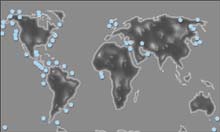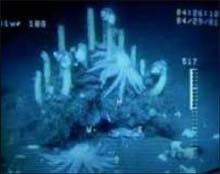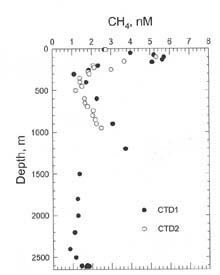
A global view of areas where methane hydrates are believed to reside among sea-floor sediments and within permafrost. Methane hydrates are a promising natural resource because they are a clean-burning fuel source and contain 160 more times the energy than an equal volume of pure methane gas. Click image for larger view.
Methane Hydrates: Gaseous Energy from the Deep
Mary Scranton, Biogeochemist
State University of New York at Stony Brook
Methane is a greenhouse gas, and, as such, plays an important role in climate change. The oceans have not been considered very important in the global methane cycle, but large reservoirs of methane exist in the continental margins, and if they were to abruptly escape to the atmosphere, the effects would be enormous. Also, if ground water or other fluid flow is transporting methane out of the sediments into the water, it may be bringing other compounds into the ocean. This could mean that organisms in the water column and in sediments are more adapted than we might expect to certain chemicals we think of as "pollutants."

Organisms crowd around methane seeps in waters off of Northern California. The methane provides energy for bacteria, which then become the basis for a long line of organisms known as a food chain. Seep communities such as these demonstrate the beneficial aspects of methane gases deep within the ocean.
Methane hydrates are molecules made up of a combination of methane gas and water. They exist under certain conditions of temperature and pressure, forming when natural-gas molecultes, comprised primarily of methane, are trapped in a "cage" of water molecules. Methane molecules are interesting because they are a bit simpler than some other chemicals, and therefore, it is easier to pick apart the pieces and understand the factors that control methane in the water column. If the temperature gets warmer or the pressure is reduced, they "destabilize" and convert back to a mixture of gas and water. My research group from Stony Brook University will collect and analyze water samples from the vicinity of the Hudson Canyon to seek evidence of methane, formed from this destabilization process, that has leaked into the water column.
Leaks, Seeps, Vents, and Plumes
Previous data from off the East Coast, as well as from other areas, has hinted that methane, produced in the sediments of the continental margins by the processes that create reservoirs of oil and natural gas, is transported out of the margins. In some places, this "leakage" results in communities of vent-like organisms. In other cases, other, possibly hazardous, compounds accompany it. Thus, it is important to understand the extent to which, and the mechanisms by which, methane is released into the water.
We already know that large volumes of methane exist in several places in

A rosette system such as this one, consisting of a frame with a number of Niskin water samplers and a CTD attached, will be used to collect water and data. The water bottles, once filled at the correct depth, are closed by an electric signal sent down from the ship.
this general area. In these places, known as maxima, methane concentrations are higher at a particular depth than they are at depths both above and below. We think that at least some of these maxima represent traces of methane seeping from the sediments. However, since little data has been obtained from deep waters, we need more samples to create a better map of any such "plumes."
Collecting Gas from Water
To do this, we will collect samples of water between the surface and 2,650 m depth using a rosette system that consists of a frame with a number of water samplers attached. These samplers, called Niskin bottles, can be lowered to the desired depth while open, and then closed using an electrical signal from the
The animals inside also will be immersed in cold water (4 degrees C) throughout their ride back to the surface, which will prevent any rapid pressure and water temperature

Methane data collected last summer during the Deep East 2001 Expedition. As graphed here, based on CTD readings, methane concentrations can be determined at various depths throughout the water column. Similar data will be collected in greater quantity during this year's Hudson Canyon research cruise. Click image for larger view.
changes that often kill most deep-sea animals brought to the surface. Deep-sea shrimp, if they are kept in the cold, dark water to which their bodies are adapted, can survive for weeks on the surface. surface. (If we lowered them closed, the pressure would rapidly crush them.) The rosette also has a CTD instrument attached to measure conductivity (salinity), temperature, and depth continuously through the water column. When we bring the samples back to the surface, we extract the dissolved gases and analyze them on a gas chromatograph.
The table (left) shows data collected last summer near the Hudson Canyon. Several maxima are recorded, near 100 m, at about 1,000 m, and near the bottom. Our goal for this cruise is to note how widespread these features are, and to find out where the methane is coming from.
Sign up for the Ocean Explorer E-mail Update List.























